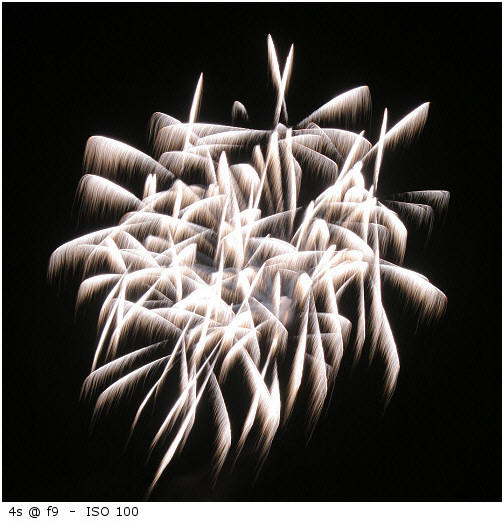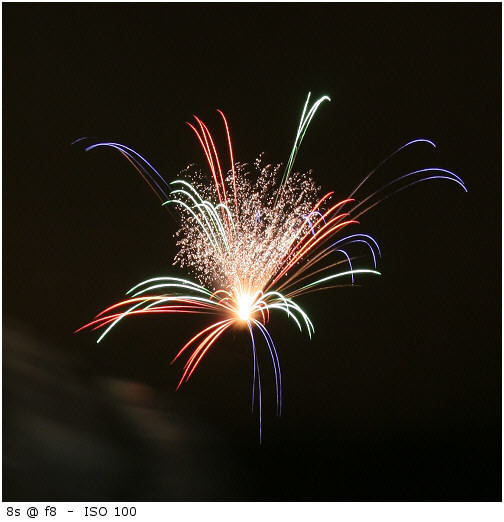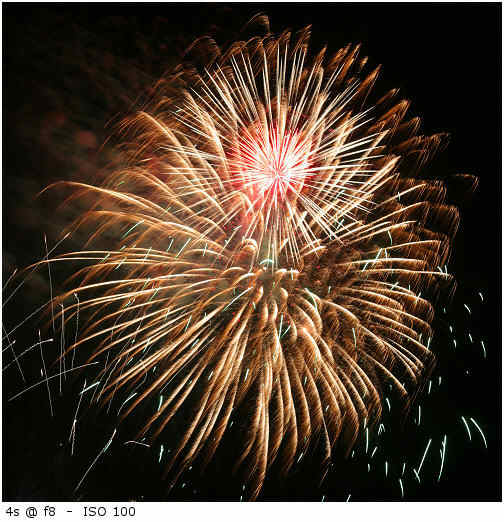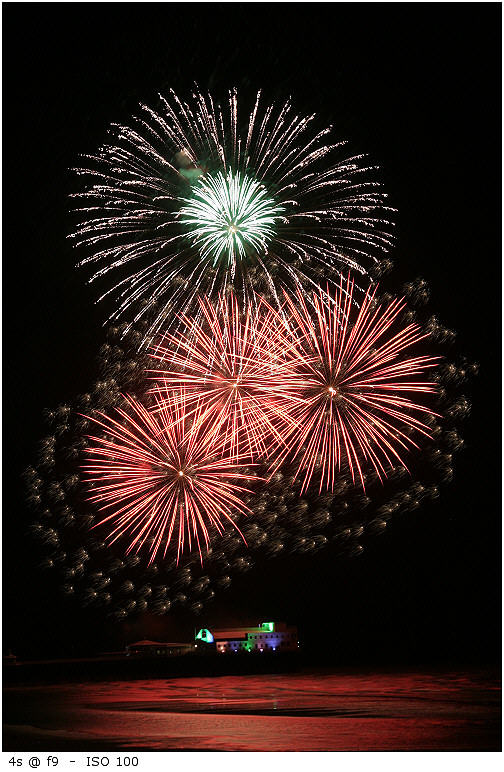

Fireworks Photography
Which camera?
All you really need in the way of equipment is a camera on which you can manually set focus, shutter speed and aperture. Normally these days that would mean a digital SLR (though a film SLR would be fine too of course), or a high end P&S type digital camera. The reason that you need to be able to manually set the camera is that autoexposure probably won't work, plus you need an exposure of several seconds in order to record fireworks bursts. You also need to be able to set the focus since there may be nothing in the frame when you open the shutter (more on that later), so AF will fail.

Which Lens?
Which lens you need depends on how close you are to the show, but I used a 17-85 zoom on an EOS 20D for a show that was about 1/2 mile from me. Most of the time I used focal lengths around 50mm. Set focus to manual and focus at the distance at which the fireworks will be from you. If you zoom, make sure that your lens keeps focus when it zooms, otherwise you may have to refocus after zooming. The Canon EF-S 17-85 doesn't noticeably shift focus when zoomed, or if it does the use of small apertures such as f8 and f11 masks any focus shift. Also, since you will be shooting stopped down, you don't really need a fast lens and even a consumer zoom usually gives good results at f8 and f11.
Camera Settings
So what camera settings work? Well a good place to start is with a 4s exposure at f8 with the camera set to ISO 100 (or using ISO 100 film). The shutter has to stay open this long to record the trails of the various components of each burst. You can also try exposures of 2s and 8s if you want less or more bursts captured. The brightness of the trails depends on the aperture and ISO setting, not on the length of the exposure. For very bright firework bursts, stopping down to f11 might give better results. With such long shutter speeds the use of a tripod is essential and the use of some type of remote shutter release (either wired or wireless) is highly recommended.

When to Shoot
The problem of course is that you don't know ahead of time how bright each burst will be, when it's coming or exactly where in the sky it will be, so there's an element of luck in capturing the image. If you wait until you see the burst, it will be over by the time you take the shot, so you have to anticipate. Sometimes you can see the rocket trail going up and that can give you a clue when to open the shutter. Ideally you want to open the shutter just before the major display occurs.It's a hit and miss process, but with digital you can afford to fire off 10 shots/minute for the duration of the display (usually displays don't last more than 15-20 minutes), though that would get a bit expensive if you were shooting film. It's worth varying exposure times and apertures a little, but bracketing around 4s at f8 and ISO 100 should usually give the best results.

It's very difficult to get good framing (except by luck) since you don't know exactly where the major bursts will occur or how high they will be. This probably means you'll need to crop your images somewhat to get the best composition. Sometimes you may get lucky though and get a shot that has everything in the right place.

Summary
- Use a tripod. You can't handhold the camera for a time exposure, even if you're using an IS lens.
- Use ISO 100. Fireworks are bright and the lower the ISO setting, the lower the image noise.
- Unless you are a really long way from the fireworks, a wide to short-tele lens should be fine.
- Stop down to around f8, maybe f11. This will give you the sharpest images and allow a long exposure.
- Prefocus the lens and switch to manual focus.
- Try shutter speeds from 2s to 8s. The longer the exposure, the longer the trails will be.
- Open the shutter while the firework is on it's way up, not when the shell explodes.
- A remote release will be useful. Use one if you have one.
- Shoot lots of images. Some will work, some won't. It's a matter of luck. The more you shoot, the luckier you may get!
Additional Images
You can find more examples of fireworks photography here in the Fireworks Gallery
If you found this article interesting, please tell others about it...